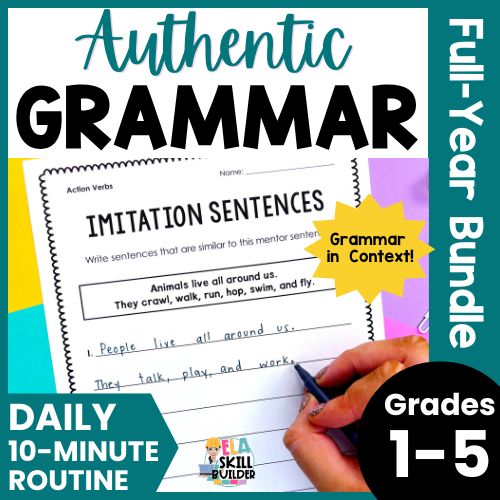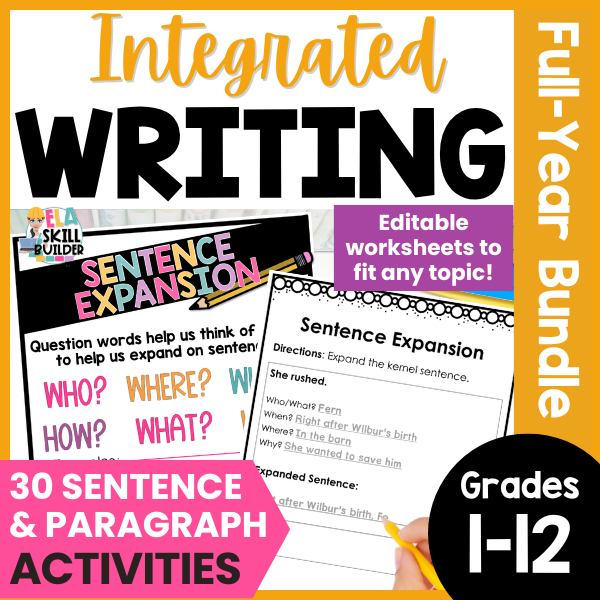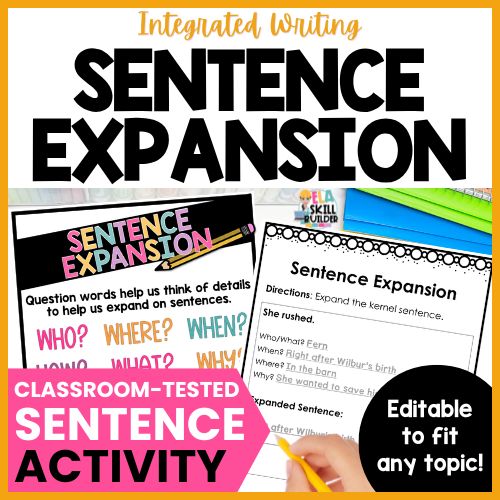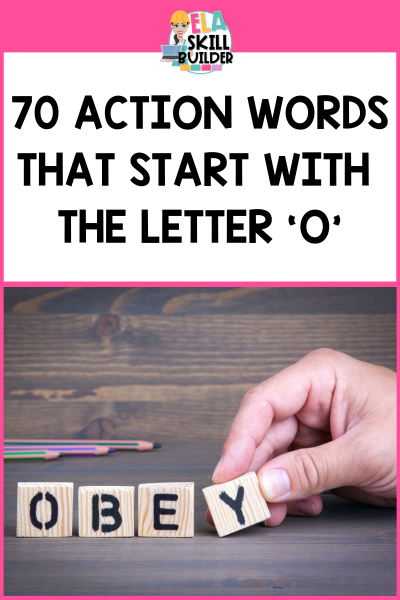

How to Run an Effective Writing Workshop in Elementary
Are you an elementary school teacher struggling to teach writing effectively? I’ve been there, discouraged by the blank stares I got when I said things like, “Add more detail to your story.”
I taught lessons on writing, but my students didn’t apply them. I knew something needed to change, and that’s when I started using the writing workshop model.
Instead of overwhelming students, I taught writing in short, focused mini-lessons and built a classroom community where students saw themselves as real writers. This approach made instruction more manageable and led to real progress. Students were more engaged, their writing improved, and they even began to enjoy the process.
Lately, I’ve heard some teachers wonder if writing workshop is outdated. The truth is, it’s not—as long as it’s implemented with clarity and purpose. When done well, it remains one of the most effective ways to teach writing. I break that down in more detail here: Is Writing Workshop Dead? Not Even Close!.
In fact, implementation of writing workshop has been associated with significant positive effects on state ELA test scores (American Institutes for Research study).
What is Writing Workshop?
Writing workshop is a structured approach to teaching writing that combines explicit instruction with time for students to practice and apply what they’ve learned. It follows a consistent routine that includes direct teaching, independent writing time, and opportunities to share and reflect.
This model gives teachers space to teach focused lessons on specific skills while also giving students the time and support they need to grow as writers. It balances clear guidance with student choice and encourages students to see themselves as capable, thoughtful writers.
Let’s break down the main components of writing workshop and how they work in the classroom.
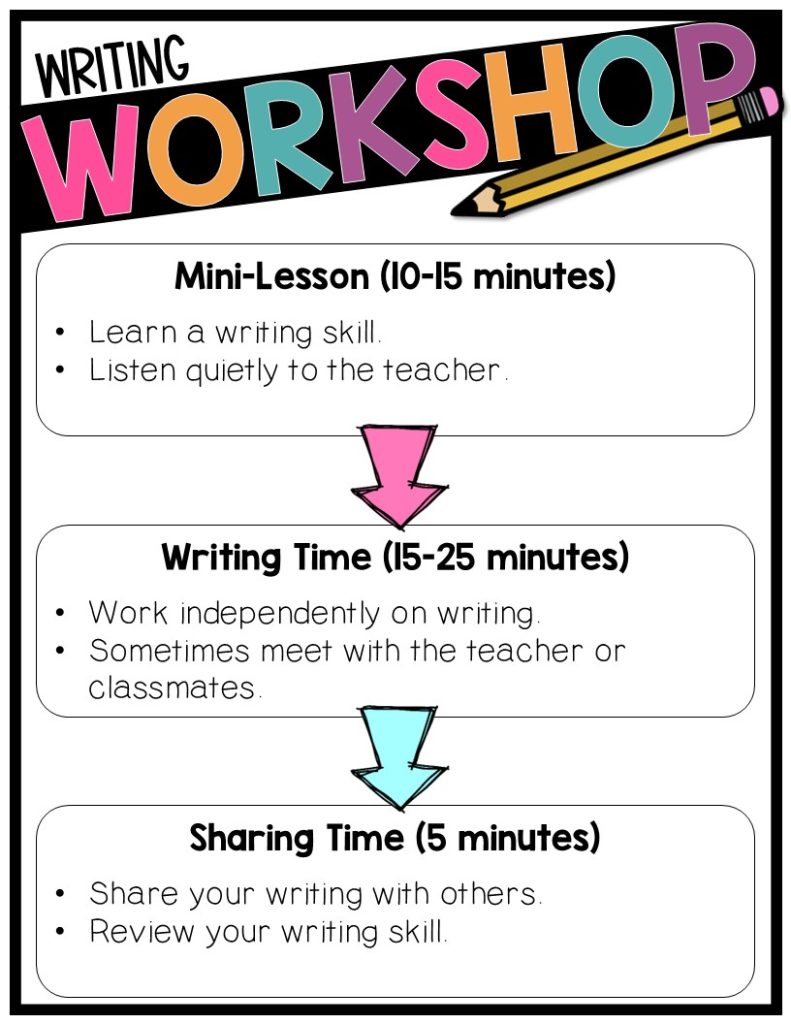
Mini-lesson (10-15 minutes)
Each writing workshop starts with a brief, focused mini-lesson that targets a single, specific skill drawn from the 6+1 traits of writing: ideas, organization, voice, word choice, sentence fluency, conventions, or presentation. To make this lesson clear and engaging, it should include a visual aid like an anchor chart that highlights the key points of the skill being taught. This visual tool helps students understand and remember the concept.
The mini-lesson also incorporates a mentor text, which demonstrates how skilled writers use the targeted writing trait effectively. By analyzing the mentor text, students see the skill in action within authentic writing.
Next, the teacher models the skill by writing a short example, thinking aloud to show how to apply the skill step-by-step. This live demonstration guides students through the process and makes the abstract concept concrete.
Finally, the mini-lesson wraps up with clear directions for students to practice using the skill in their own writing that day. This structure ensures students understand the skill, see it modeled, and then have a chance to apply it immediately, setting a strong foundation for the rest of the writing workshop.
Independent writing time (15-25 minutes)
After the mini-lesson, students move into independent writing time, which is really the heart of the writing workshop. During this time, children have the chance to develop their own ideas and work through the writing process. This means brainstorming, drafting, revising, and sometimes even editing – all while applying the new skill they just learned in the mini-lesson. Independent writing time gives students space to experiment with their writing voice and make meaningful choices about what and how they write.
In addition to working solo, students often collaborate with peers for feedback or support. This interaction encourages them to think critically about their own writing and learn from others. This focused writing time builds independence and confidence as writers develop their skills and personal style.
Conferencing (during writing time)
While students are writing, the teacher uses this time to meet individually with students in short, purposeful conferences. These one-on-one sessions allow the teacher to connect personally with each writer, better understand their unique strengths and challenges, and offer targeted guidance to help them grow.
Conferences aren’t just about fixing mistakes – they’re an opportunity to encourage students, ask questions about their ideas, and celebrate progress. They also create space to talk about the student’s interests, life experiences, and thought processes. Over time, these conversations build trust and a positive writing community in the classroom.
Many teachers find that conferences quickly become some of the most rewarding moments of the day. Students often look forward to sharing their work and getting personalized support, and teachers gain valuable insight that shapes future instruction. My students and I both came to truly enjoy these conferences as a key part of the writing workshop experience.
| During writing time, the teacher can… | During writing time, the students can… |
|---|---|
| Work with a strategy group – Do you have a handful of reluctant writers? Spend the first few minutes of work time attending to their needs. | Write Independently – Students need lots of time to brainstorm, write, and revise. |
| Conference one-on-one– Essential for giving meaningful feedback to students. | Partner Work – Many children benefit from verbally processing their ideas aloud. |
| Circulate – Walk around to glance at everyone’s work and assess their progress. Look for children who have tried out the skill taught in the mini-lesson to invite up during sharing time! | Read the Room – Set up areas of the room children can use to support the writing process. For example, reading an interactive word wall or sitting by an anchor chart. |
Sharing time (5 minutes)
Sharing time at the end of each writing workshop helps bring the whole session full circle. It gives students a chance to celebrate their hard work by sharing a piece of their writing with classmates. Whether this happens in a large group, small groups, or with partners, sharing allows writers to hear different voices and styles, which can inspire and motivate them.
To make sharing meaningful and purposeful, keep an eye out during independent writing for students who have successfully applied the skill or strategy taught in the mini-lesson. Invite these writers to share their writing or talk about how they used the skill. This not only recognizes their effort but also helps other students see practical examples of the skill in action.
Encourage students to listen respectfully and offer positive feedback. Sometimes sharing also opens up brief discussions about writing choices or ideas, deepening students’ understanding. This routine builds a supportive writing community where students feel valued and motivated to grow as writers.
Benefits of the Writing Workshop Model
The writing workshop model offers a structured yet flexible approach that supports both teachers and students. It creates an environment where students are actively engaged in the writing process and take ownership of their growth as writers.
Here are a few key benefits of using the writing workshop model in elementary classrooms:
- Promotes independence and confidence. Daily writing time and choice in topics help students see themselves as capable, creative writers.
- Provides consistent structure. The workshop follows the same routine each day, which helps students know what to expect and how to use their time effectively.
- Supports differentiation. Teachers can meet with students individually or in small groups during independent writing time to provide targeted instruction and feedback.
- Encourages meaningful writing. Students write for real purposes and audiences, which makes their work feel more relevant and engaging.
- Builds a community of writers. Sharing writing regularly allows students to learn from each other, celebrate progress, and build confidence in a supportive environment.
Overall, the writing workshop model helps students develop the skills, habits, and mindset they need to grow as writers throughout the year.
In a study done in a first-grade classroom where the writing workshop model was implemented for seven weeks, an interviewed student commented:
“I’m a good writer now. I’m a good writer because I add more details to my story after my friends ask me questions. My friends really liked my story when it was my turn to share. They clapped and they said it was good.’’

– 1st Grade Student, Acedemia Case Study on Implementing Writing Workshop
How to Run a Writing Workshop
If you’re new to writing workshop, it can feel like a lot to figure out. Where do you start? How do you make sure you’re covering the right skills? And what does a typical day even look like?
This section walks you through how to run a writing workshop in your elementary classroom, step by step. It’s designed for teachers who are just getting started, but even if you’ve tried writing workshop before, this framework will help you fine-tune your planning and stay focused on what matters most – supporting your students as they grow into confident, capable writers.
Let’s break it down:
1. Choose a Writing Genre to Focus On
Start by selecting the type of writing your students will be working on. The three main genres in most elementary writing standards are:
- Narrative (personal or fictional stories)
- Opinion (sharing a point of view and supporting it)
- Informative (teaching or explaining a topic)
Stick to one genre at a time so your students have the chance to go deep and really understand how that kind of writing works.
2. Identify the Writing Standards for That Genre
Once you’ve chosen your genre, take a look at the specific standards that apply to it for your grade level. These standards will guide what you teach and help you stay focused on what your students need to learn.
I’ve put together blog posts that break down the writing standards by genre for each grade. You can find them here:
3. Create a List of Objectives Based on the Standards
Now that you know your standards, break them down into clear, student-friendly objectives. These will become the focus of your mini-lessons and will help you track progress throughout the unit.
Not sure where to start? I have a free writing scope and sequence that includes a list of standards and ready-to-use objectives for grades 1–5. You can grab it here:
👉 Free Writing Scope and Sequence for Grades 1–5
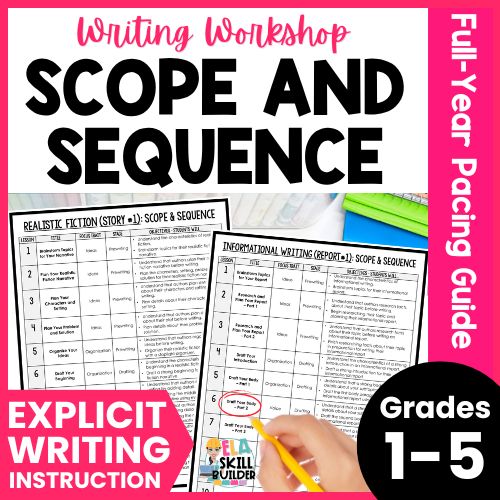
4. Create Lesson Plans That Support Your Objectives
Mini-lessons are short, focused lessons (usually 10–15 minutes) that directly teach a skill your students need in order to meet your objectives. Over the course of a unit, your mini-lessons should scaffold the writing process and incorporate the 6 Traits of Writing:
- Ideas
- Organization
- Voice
- Word Choice
- Sentence Fluency
- Conventions
Here’s a suggested timeline for moving through the writing process during your unit:
- Week 1: Prewriting (focus on Ideas and Organization)
- Weeks 2: Drafting (focus on Voice and Word Choice)
- Week 3: Revising and Editing (focus on Sentence Fluency and Conventions)
- Week 4: Publishing (focus on Presentation)
Each stage should include lessons that connect to your objectives, give students time to practice, and allow space for teacher feedback through conferences or small group instruction.
Example Lesson Plan: Intro to Realistic Fiction
Here’s an example of a lesson plan from the prewriting stage of a realistic fiction unit. In this lesson, students brainstorm realistic fiction story ideas by thinking about characters, problems, and settings they know well. The focus trait is Ideas because students are generating and collecting strong story seeds they can later develop into full narratives.

5. Compile Materials to Support Your Mini-Lesson
Visual Aid – Poster
Strong visuals help reinforce your teaching and give students a reference point they can return to as they write. For each mini-lesson, plan to have a poster or anchor chart that clearly introduces the skill or concept you’re focusing on.
These visuals don’t need to be complicated. In fact, simple, clear posters are often the most effective- especially when they focus on one idea or skill at a time.
For example, when introducing your students to the genre of realistic fiction, you might use a poster like the one below. It breaks down what realistic fiction is, what kinds of characters and settings are typically included, and what problems might arise in this kind of story.

Having this kind of visual anchor not only supports your mini-lesson but also gives students a helpful reminder they can refer to during brainstorming and drafting.
Mentor Text
Along with your visual aid, choose a mentor text that clearly demonstrates the writing skill or concept you are teaching. A strong mentor text provides students with a real example of the skill in use, making it easier for them to understand and apply it in their own writing.
For an introduction to realistic fiction, for instance, you could use the book Caps for Sale as your mentor text. This story showcases many characteristics of realistic fiction – such as believable characters, everyday settings, and problems that feel authentic to life. As you read or share excerpts from the text, point out these elements so students can see how the author uses them to craft the story.
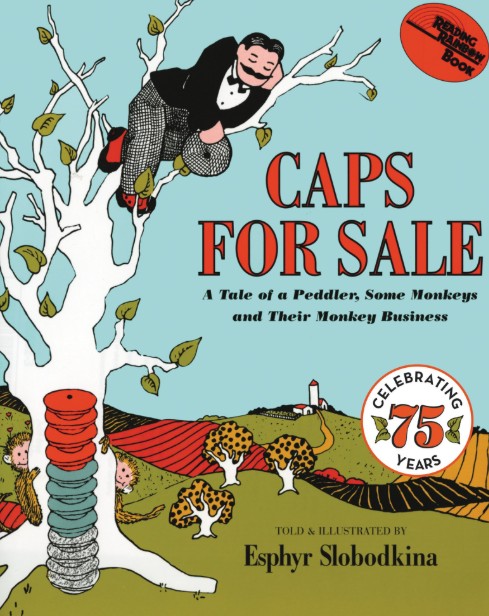
Using a mentor text in this way connects your mini-lesson to real writing, helping students grasp the skill in context and inspiring them as they work on their own pieces.
6. Compile Graphic Organizers to Support Students During Writing Time
Graphic organizers are powerful tools that help students organize their thoughts and plan their writing. They provide a clear structure that guides students through each stage of the writing process, making it easier for them to focus on developing their ideas and skills.
Using graphic organizers can reduce overwhelm, especially for students who struggle with getting started or keeping their ideas organized. They also encourage students to think critically about the parts of their writing, like the sequence of events in a story or the reasons supporting an opinion.
For example, during the prewriting stage of a realistic fiction unit, you might use a brainstorming graphic organizer like this:
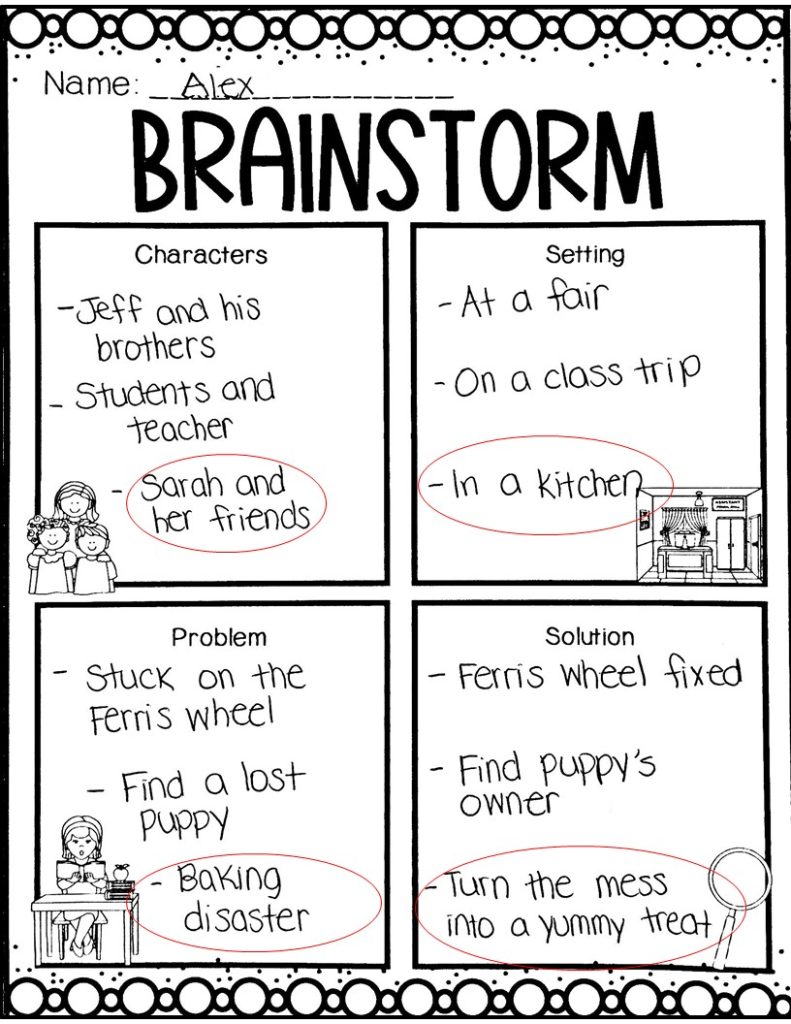
This organizer prompts students to think about characters, setting, and problems—key elements in realistic fiction stories. It helps them gather their ideas before moving on to drafting.
Before asking students to use the graphic organizer on their own, be sure to model how to fill it out during your mini-lesson. Walk through each section, thinking aloud as you demonstrate how to organize ideas clearly and effectively. This modeling helps students understand the purpose of the organizer and builds their confidence to use it independently during writing time.
Including graphic organizers as part of your writing workshop gives students a consistent support system that builds independence and confidence as writers.
Skills to Cover in Writing Workshop
When planning your writing workshop, it helps to break down the writing process into manageable stages. At each stage, you can focus mini-lessons on specific skills that connect to the 6 Traits of Writing. This approach ensures your instruction is purposeful and targeted, helping students build confidence and competence step by step.
Below is a list of possible skills to cover in each stage of the writing process. These are designed to be taught as focused mini-lessons that scaffold student learning from generating ideas all the way through publishing. By aligning your lessons with the traits, you’ll help students develop both the craft and the habits of effective writers.
Prewriting
Focus Traits: Ideas, Organization
- Generating story ideas (brainstorming techniques)
- Choosing a strong, clear main idea or topic
- Using graphic organizers to plan story structure or informational content
- Identifying and organizing key details to support ideas
- Planning a logical sequence of events for narratives
- Creating an outline for opinion writing with reasons and examples
- Mapping out characters, setting, and problem for realistic fiction
- Determining the purpose and audience for writing
- Using graphic organizers to sort facts and research for informative writing
Drafting
Focus Traits: Voice, Word Choice
- Writing strong leads or introductions that grab attention
- Developing characters with specific traits and actions
- Using dialogue to show character feelings and advance the story
- Showing rather than telling: Using descriptive language to create vivid images
- Choosing precise and vivid vocabulary to make writing more engaging
- Using transition words to connect ideas smoothly
- Writing clear topic sentences for paragraphs
- Expressing opinions clearly with supporting details
- Using facts and examples to explain ideas in informative writing
- Maintaining a consistent voice that matches the genre and purpose
Revising & Editing
Focus Traits: Sentence Fluency, Conventions
- Combining short sentences to improve flow and rhythm
- Varying sentence beginnings and lengths for better sentence fluency
- Using linking words and phrases to connect ideas smoothly
- Checking for clarity and coherence in ideas and organization
- Peer conferencing: Giving and receiving feedback on content and style
- Correcting spelling errors and using resources like word walls or dictionaries
- Capitalization rules (proper nouns, sentence beginnings, titles)
- Punctuation: periods, commas, question marks, quotation marks
- Correct use of grammar: subject-verb agreement, verb tense consistency, pronouns
- Fixing common errors in sentence structure (fragments, run-ons)
Publishing
Focus Trait: Presentation
- Using digital tools to publish and share writing, if available
- Writing final drafts neatly and clearly
- Using headings, subheadings, and captions for informational writing
- Formatting paragraphs and spacing for readability
- Creating a title that fits the writing piece and grabs attention
- Reflecting on the writing process and setting goals for future writingSharing writing with classmates or family (author’s chair, publishing party
Essential Routines for an Effective Writing
Routines are the backbone of a successful writing workshop. They create a predictable, organized environment where students know what to expect and what’s expected of them. When routines are clear and practiced regularly, students can focus more on writing and less on managing transitions or behavior. Below are key routines to establish for a smooth and productive workshop.

- Prepare Well: Organize Materials and Space
Use writing folders to keep work organized—prewriting on one side, drafts on the other. Set up a consistent spot for mini-lessons to help students focus. - Routines for Mini-Lessons
Students sit quietly, listen actively, ask questions when needed, and participate when prompted. - Routines for Independent Writing
Students start writing right away, write throughout the session, do their best with spelling and grammar, and know what to do if they finish early (revise or start a new piece). - Routines for Conferencing
Meet in a designated spot. Discuss strengths, set goals, provide focused feedback, and help students apply goals before the next conference. - Routines for Peer Collaboration
Use pairing strategies and set expectations for respectful behavior, helpful feedback, and clear communication. Model and practice these routines regularly. - Routines for Sharing Time
Teach students how to present their writing clearly and confidently. Encourage active listening from the audience and guide students on giving specific, positive feedback that helps their peers grow.
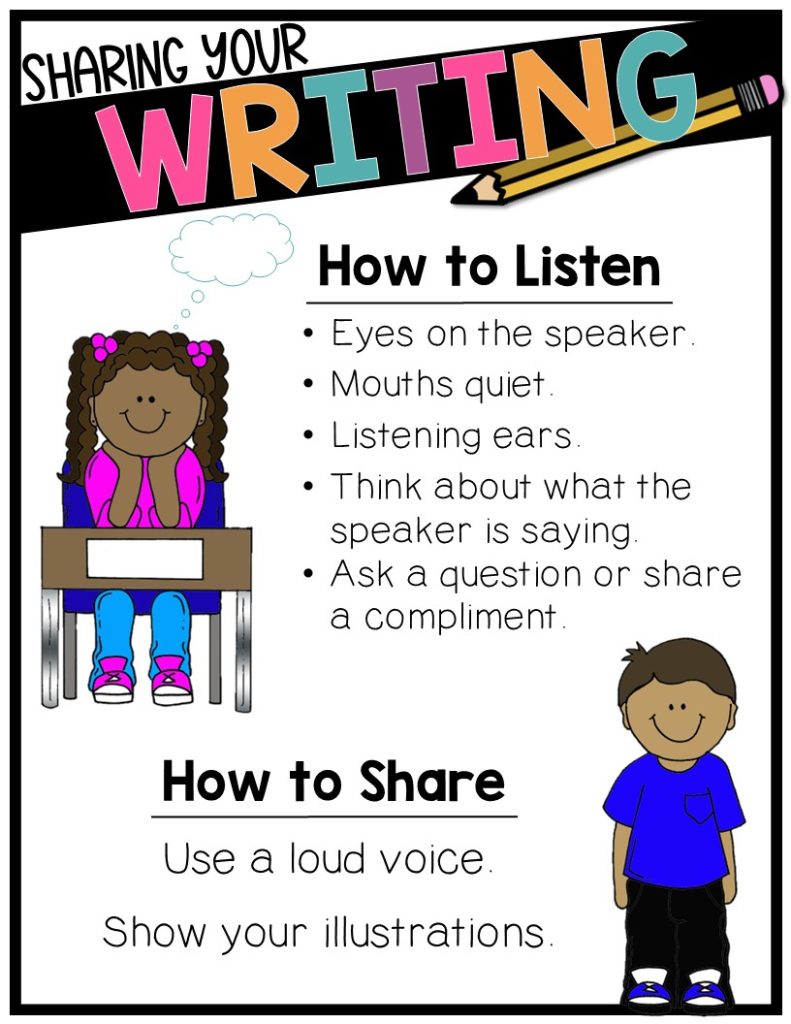
Assessing and providing feedback on writing assignments
Assessment is a key part of running an effective writing workshop. It helps you understand where each student is in their writing development and guides your instruction moving forward. There are two main ways to assess writing that work well within the workshop model: informal assessment through conferencing and formal assessment using rubrics.
Informal Assessment: Conferences
Writing conferences give you a chance to meet with students one-on-one or in small groups to discuss their work in progress. These conversations let you address strengths and areas for improvement in real-time. During conferences, you can celebrate what students are doing well and offer specific, actionable feedback to help them move forward. This ongoing support keeps students motivated and helps them make steady progress throughout the writing process.
Formal Assessment: Rubrics
Rubrics provide a clear framework for evaluating student writing based on the skills and traits you’ve taught. Your rubrics should reflect the 6 Traits of Writing—ideas, organization, voice, word choice, sentence fluency, and conventions—and align with the mini-lessons your students have completed. Sharing the rubric with students before they begin writing helps them understand the expectations and what success looks like. For teachers, rubrics offer an objective way to assess writing and provide meaningful feedback that supports growth.learning environment.
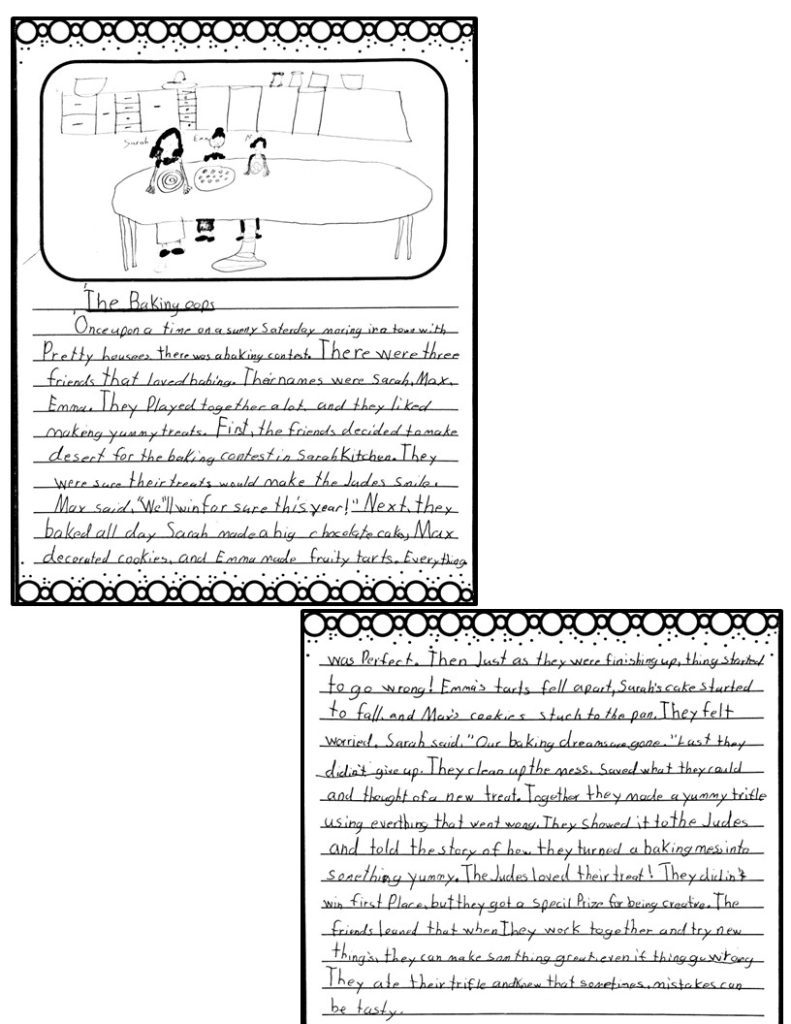
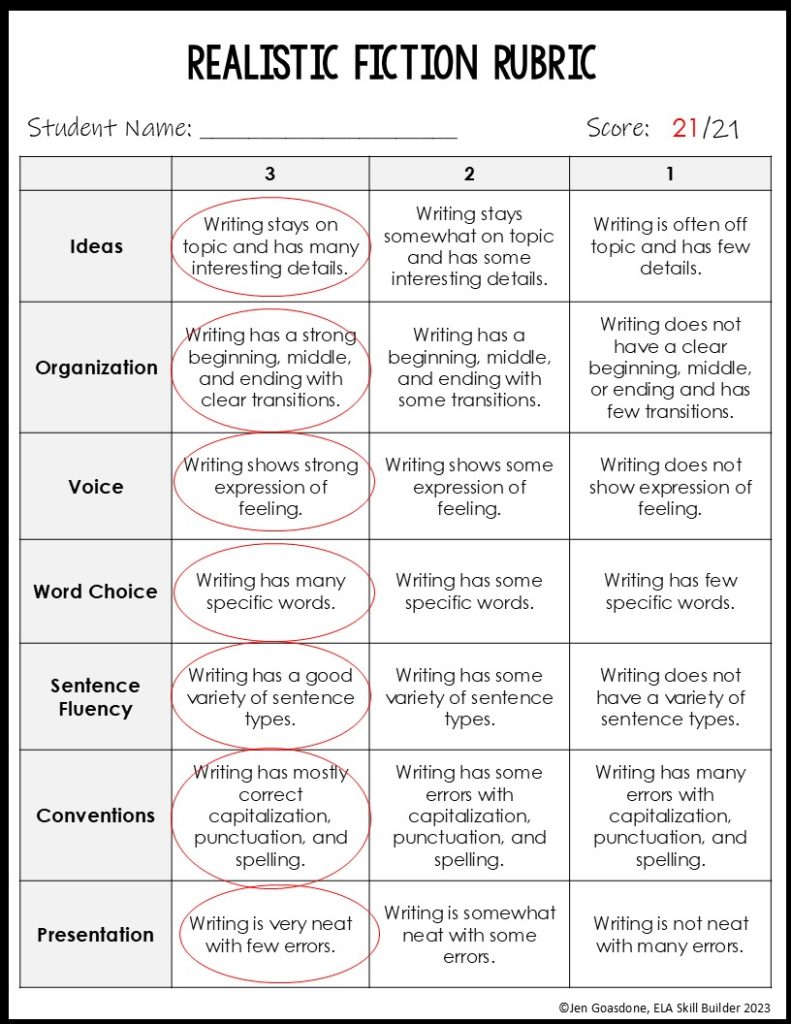
Try This: FREE Prewriting Lessons for Narrative Writing
Ready to get started with writing workshop? Try implementing these 5 prewriting lessons for narrative writing. They include explicit, easy-to-follow lessons designed to help your students brainstorm and plan their narrative stories with confidence. These lessons will give you a solid foundation to launch your workshop and set your writers up for success!
Click here to grab 5 free prewriting lessons for a narrative unit!
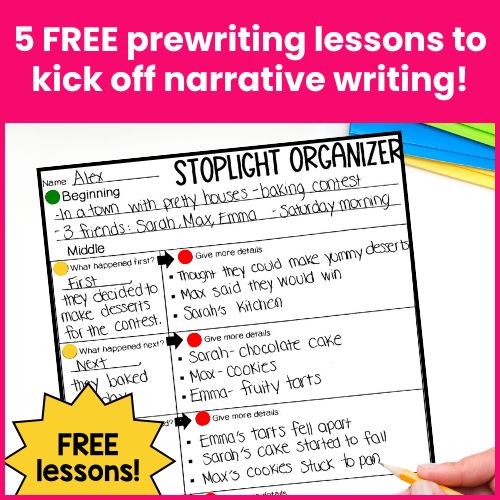
Conclusion
Running an effective writing workshop in an elementary classroom takes planning and intentional instruction, but the results are well worth the effort. By breaking writing into clear stages, focusing on targeted mini-lessons, and using tools like visuals, graphic organizers, and ongoing assessment, you create a supportive environment where all students can grow as writers.
Remember, writing workshop is flexible and adaptable—adjust your lessons to meet your students’ needs and watch their confidence and skills improve over time.


Hey Teachers,
I'm Jen from
ELA Skill Builder!
My mission is to empower elementary teachers like you with the tools and confidence to teach writing effectively, so your students can grow into strong, capable writers.
Best Sellers!
Writing resources
Features explicit writing workshop lessons for narrative, informational, and opinion writing.
Grammar resources
Features a simple weekly routine that teaches grammar in context in just 10 minutes a day.
writing prompts
Features 810 prompts designed to strengthen paragraph writing skills all year long!
cross-curricular writing
Features 30 sentence and paragraph activities inspired by The Writing Revolution that fit any subject.
coupon code
Get 15% off Your First Purchase
free lessons!
Grab 5 free prewriting lessons to kick off your narrative writing unit – all materials included!
jOIN A COMMUNITY
writing training
Features 4 hours of video lessons designed to help you run a structured, effective, and engaging writing block.
free gramamr routine!
Features a free 5-day routine for teaching any grammar skill in context, in just 10 minutes a day!
free SENTENCE ACTIVITY
Features a free, editable sentence activity that helps students expand sentences for any topic.
contact jen!
Got questions? Fill out this contact form, and I’ll get back to you as soon as possible.




